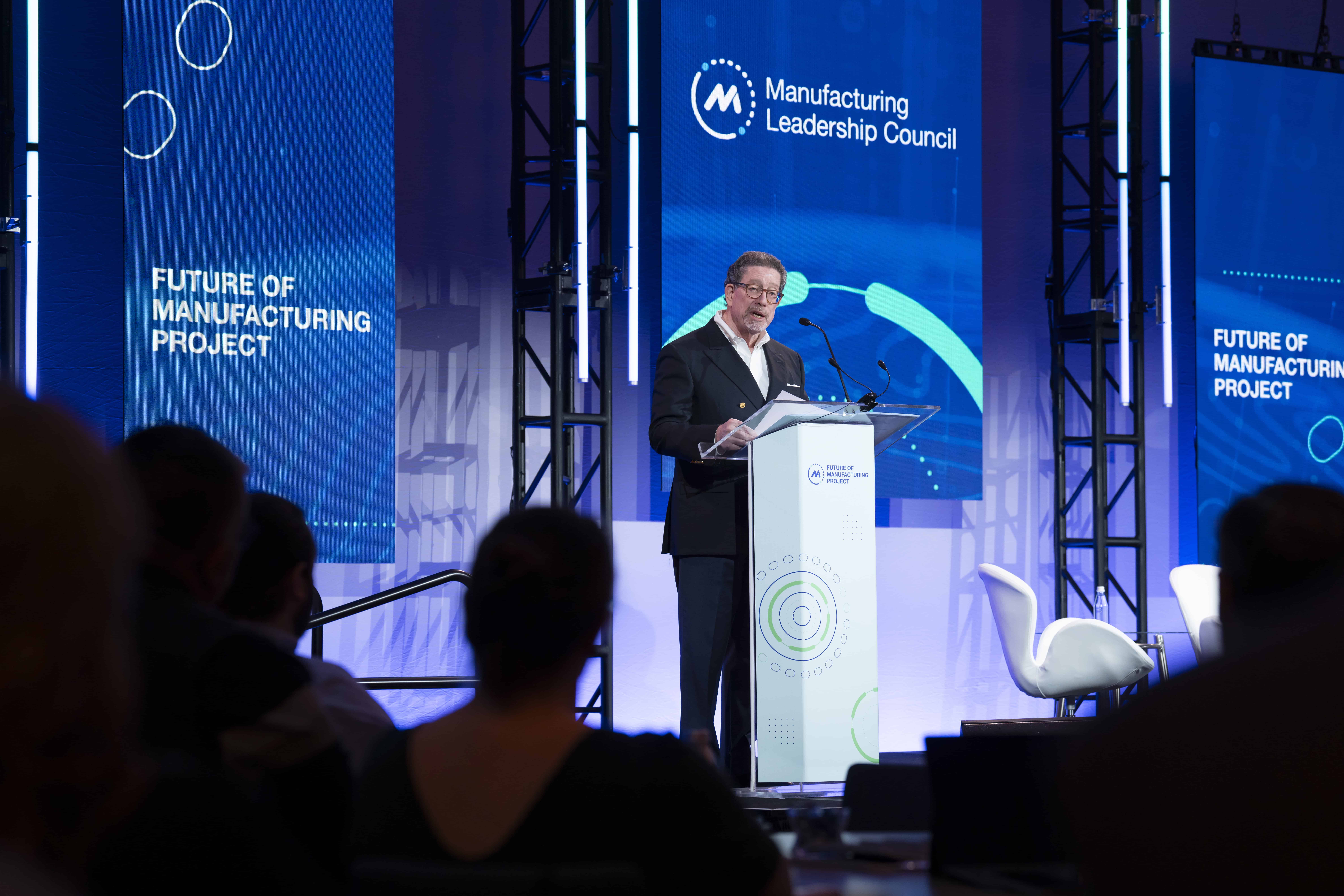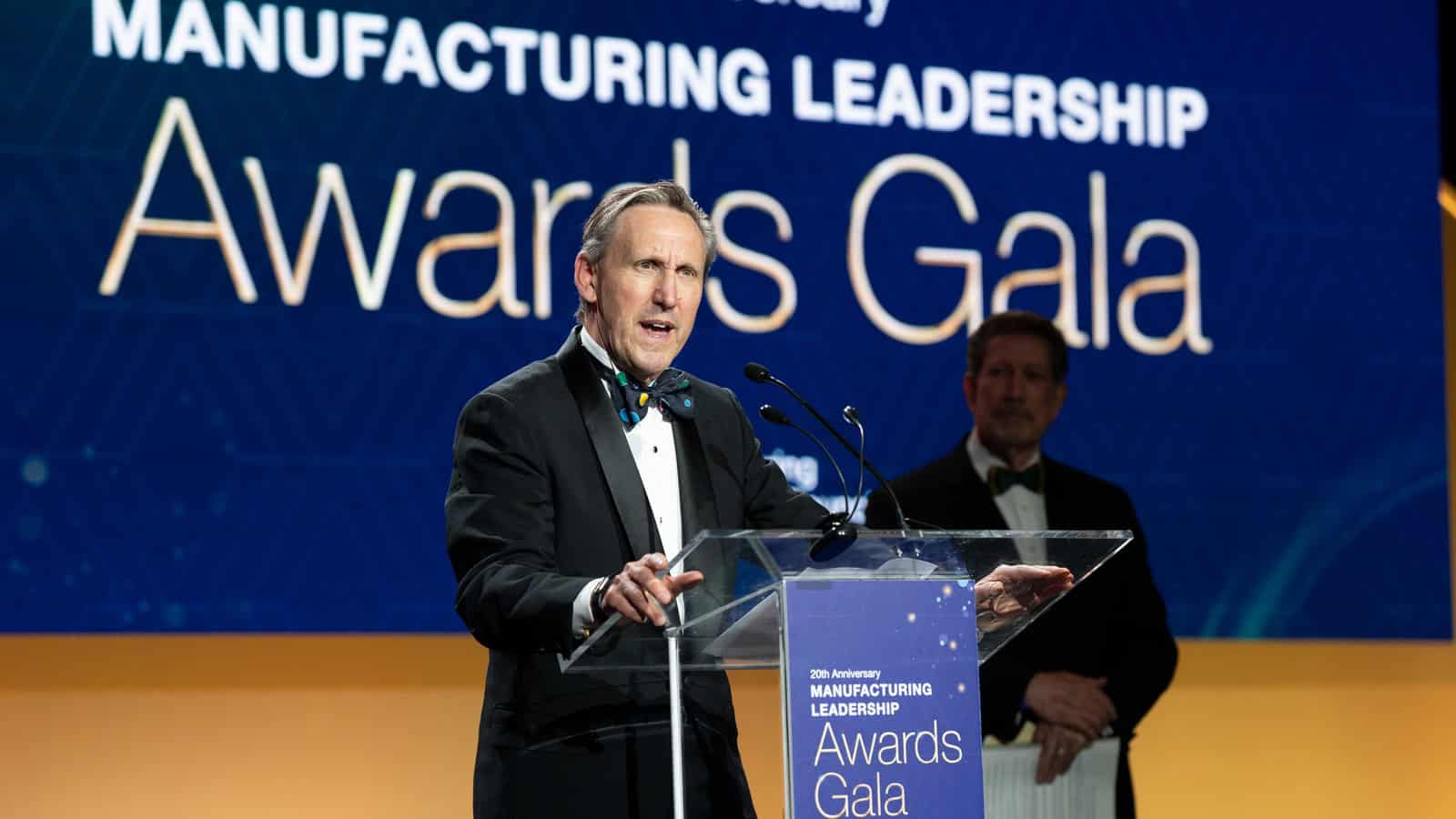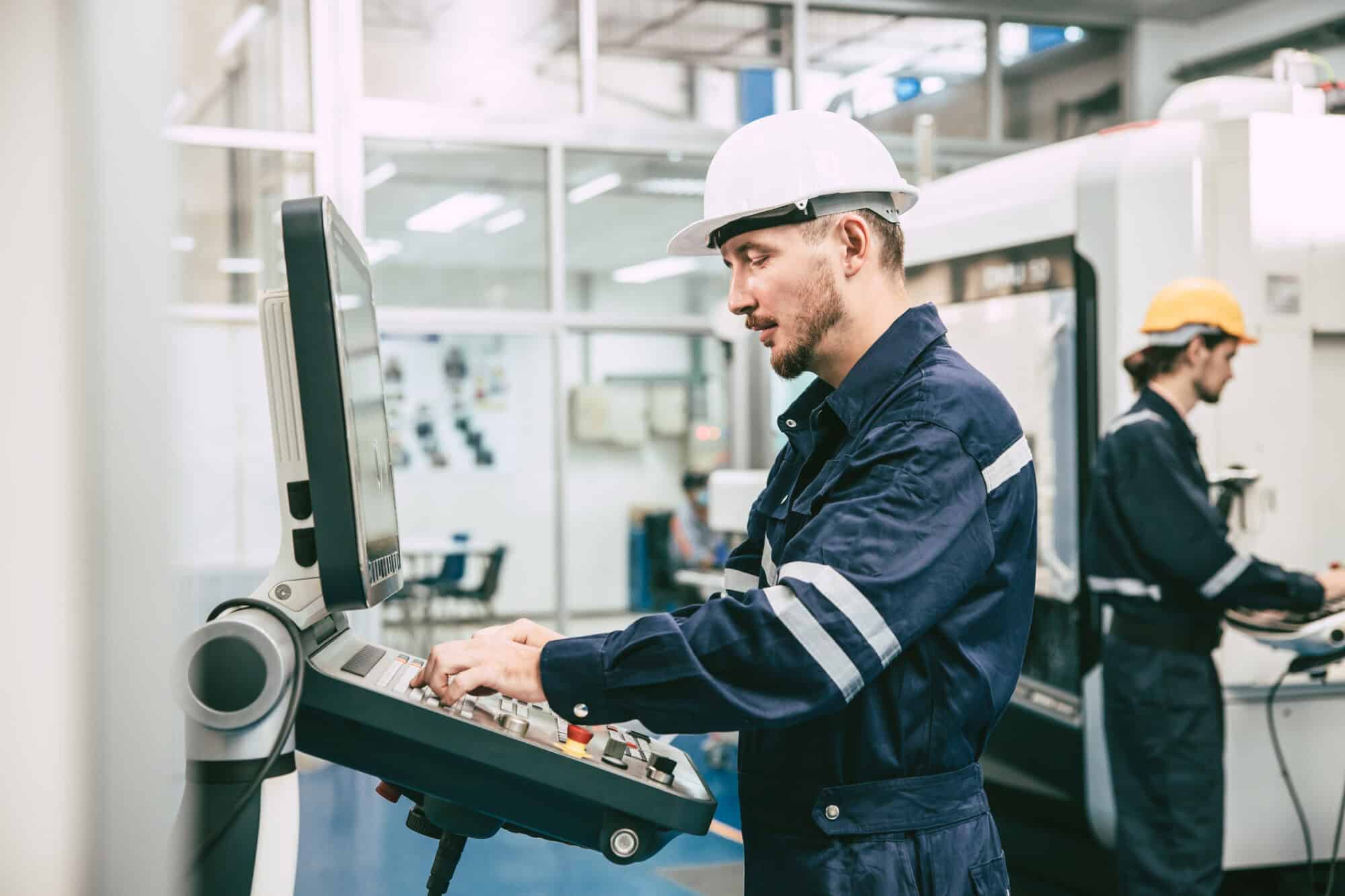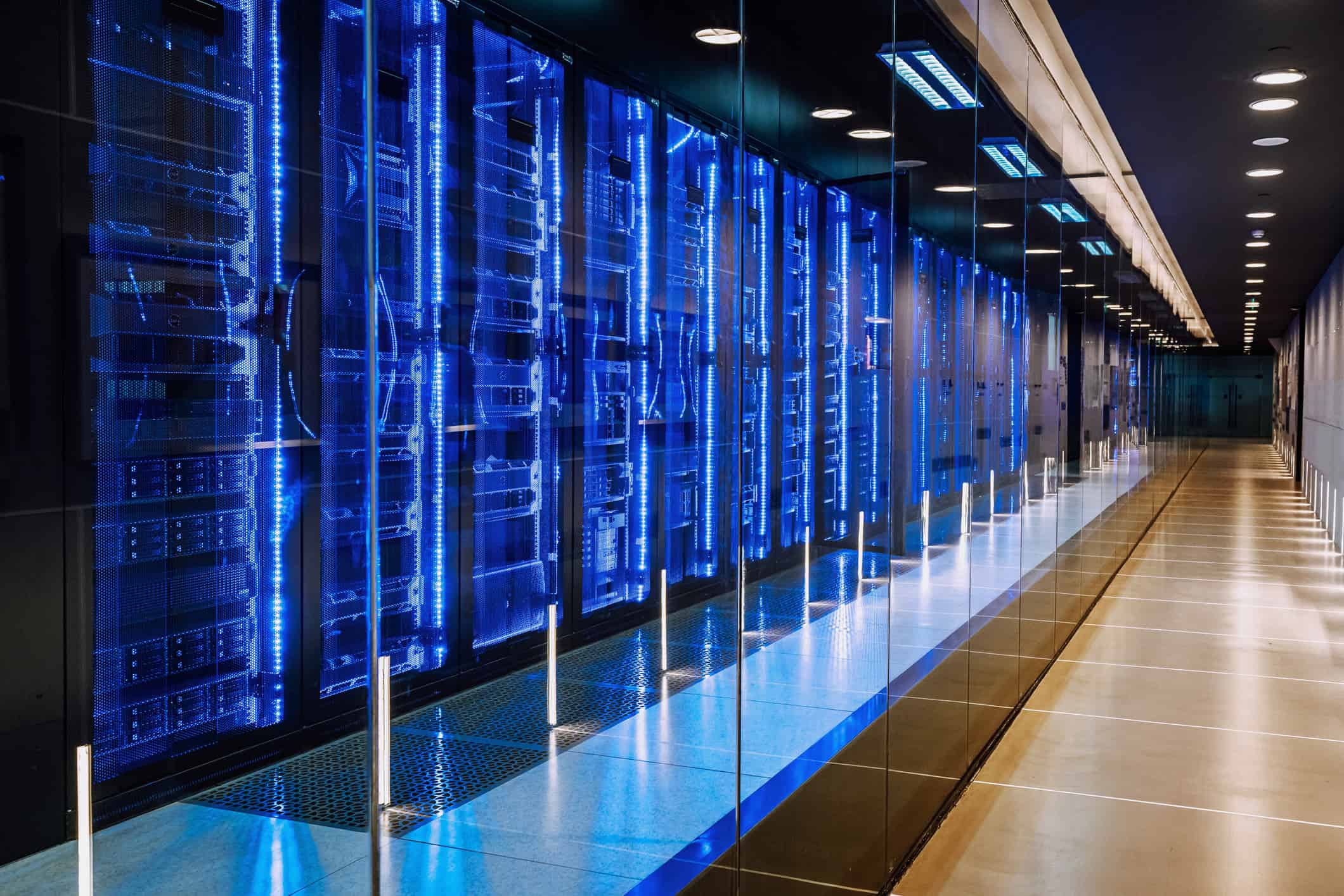MLC Announces Finalists of Manufacturing Leadership Awards
 The Manufacturing Leadership Council, the NAM’s digital transformation division, has announced its list of finalists for the Manufacturing Leadership Awards—an honor given to world-class manufacturing companies and leaders who are revolutionizing the industry’s digital capabilities.
The Manufacturing Leadership Council, the NAM’s digital transformation division, has announced its list of finalists for the Manufacturing Leadership Awards—an honor given to world-class manufacturing companies and leaders who are revolutionizing the industry’s digital capabilities.
The big reveal: All finalists will be celebrated at the ML Awards gala on June 18 in San Marco Island, Florida, where the winners will be announced.
- The awards given include the Future of Manufacturing Award, the Manufacturing Leader of the Year, the Small/Medium Enterprise Manufacturer of the Year and Large Enterprise Manufacturer of the Year.
- Manufacturers can also win awards in several categories, including artificial intelligence vision and strategy, business model transformation, collaborative ecosystems and more.
- Award nominations were judged by a distinguished group of manufacturing leaders from across the industry.
- You can see a complete list of finalists here.
Rethink: Ahead of the Awards gala, the MLC will be hosting Rethink, where manufacturing leaders gather to learn best practices and make connections. The star-studded lineup includes:
- A keynote address on digital transformation from Siemens USA President and CEO Barbara Humpton;
- A talk on “How Wall Street Views Digital Transformation in Manufacturing” by Goldman Sachs Managing Director, Technology, Media and Telecommunications Group Jack Anstey;
- An inside look at Hershey’s digital factory, featuring The Hershey Company Vice President of Manufacturing and Engineering and MLC Board of Governors member Will Bonifant; and
- Numerous case studies, best practice sessions, networking opportunities and more.
The last word: “In times of business uncertainty, manufacturers find that investments in digital technology can pay off for improving efficiency and overall performance and innovation,” said MLC Founder, Vice President and Executive Director David Brousell. “In our 21st season of recognizing excellence in Manufacturing 4.0, it is remarkable to witness the innovative methodologies that manufacturers are continually developing to propel their digital transformation initiatives.”
Join us: If you’d like to learn more about Rethink or register for the conference, go here.
Digital Transformation Sees Explosive Growth

Manufacturers are increasing their investments in digital assets, according to a recent survey from the Manufacturing Leadership Council, the NAM’s digital transformation division.
What’s going on: Due in large part to expectations of economic growth, manufacturers plan to either maintain or boost their spending on smart factory investments, they told the MLC in the recently published results of the Smart Factories and Digital Production Survey.
- Respondents also said they are optimistic about continued digitization and adoption, with 69% expecting moderate growth and no recession.
- While 28% would call their current operations “smart” or “somewhat smart,” 76% expect to be there in the next two years.
- Awareness of AI is growing by leaps and bounds among manufacturers; some 34% said they see AI as very significant. (Last year, just 10% said the same.)
Key points: The survey’s top takeaways include the following:
- Digital transformation is changing the game: Most manufacturers—60%—see digital transformation as something that is redefining the industry.
- More manufacturers are going digital: Some 75% of manufacturers say they are at “midlevel” digital maturity, up significantly from 2024 and 2023.
- AI’s role is inevitable: Fully 80% of manufacturers fully or partially agree self-managing and self-learning facilities powered by AI and machine learning are coming.
Rethink 2025 Is Coming Up Fast

Get ready! Manufacturing’s leading annual event on accelerating digital transformation is right around the corner.
What’s going on: Rethink—held by the Manufacturing Leadership Council on Marco Island, Florida, each June—is a must-attend conference for anyone interested in Manufacturing 4.0 and where it’s headed (The MLC is the digital transformation division of the NAM.)
- This year’s event takes place June 15–18 at the JW Marriott Marco Island Beach Resort.
Why you should go: Rethink attendees will get an inside look at the cutting-edge processes and technologies transforming manufacturing today—directly from those creating and implementing them. They’ll also get a chance to:
- Consult with peers on manufacturing’s most critical initiatives, including smart factories and digital production, resilient supply networks and analytics and data mastery;
- Participate in real-time discussions and one-on-one meetings to help them understand how various solutions can solve their business problems;
- Hear from industry leaders and experts during panel discussions, executive interviews and more;
- Interact and collaborate with peers during interactive “think tank” sessions; and
- Hear from the MLC’s event partners during Rethink’s exclusive VIP Tour.
Who will be there: Scheduled speakers include Siemens USA President and CEO Barbara Humpton, Eaton Vice President of Industry 4.0 Craig Sutton, Hershey Company Vice President of Manufacturing, Operations Technology and Supply Chain Strategy Will Bonifant, Rockwell Automation Senior Vice President of Intelligent Devices Tessa Myers and many more.
The gala: Closing out the packed three-day event is the Manufacturing Leadership Awards Gala, at which the MLC will recognize award finalists and winners of the Future of Manufacturing Award, the Manufacturing Leader of the Year, the Small/Medium Enterprise Manufacturer of the Year and the Large Enterprise Manufacturer of the Year. The gala will take place on the evening of June 18.
Attend: Register online here for Rethink 2025. (NAM members get a discount at checkout.) Questions? Send them to [email protected].
All Aboard the AI Train as Manufacturing Leaders Embrace the Future

The Manufacturing Leadership Council’s 2024 Future of Manufacturing Project event drew forward-thinking manufacturing leaders to Orlando, Fla., for a deep dive into AI-centered factories of the future. The Future of Manufacturing Project is an on-going initiative focused on key trends manufacturers must understand today to help them realize a better future.
David R. Brousell, MLC’s Founder, Vice President and Executive Director, opened the event with a sweeping overview of AI’s transformative role in the manufacturing sector and beyond. He began by highlighting the explosive growth of generative AI tools like ChatGPT, which became a global phenomenon almost overnight. Brousell explained how this rapid adoption of AI has served as a critical inflection point, fueling innovation, competition and investment at unprecedented levels across industries and nations. He underscored the staggering economic potential of AI, citing projections that it could contribute nearly $20 trillion to the global economy by 2030.
“A worldwide competition for dominance in AI is underway — and it appears to be intensifying,” Brousell said.
Major investments and initiatives by the U.S., China and Saudi Arabia highlight the AI race. He illustrated how these efforts reflect the high stakes of AI’s development, with nations and corporations alike vying for leadership. However, he cautioned against overhyped expectations, acknowledging the historical challenges of AI adoption and the – unlikely as it may seem – potential for a third AI winter. To navigate these uncertainties, he emphasized the importance of understanding both the opportunities and the risks that AI presents.
Drawing from MLC research and recent industry studies, the opening address included key findings on how manufacturers perceive and are implementing AI. While most manufacturers recognize AI as a game-changing technology, only a small percentage rate their current AI maturity as advanced. Despite this, many companies are ramping up their investments and seeing early signs of positive returns, particularly in areas like operational efficiency and productivity. Brousell also identified significant challenges, such as data quality, skill gaps and the need for metrics to measure AI’s impact.
To guide manufacturers in their AI journeys, Brousell offered practical recommendations: think big and envision bold possibilities, stay informed on technological advancements, collaborate with industry communities, establish ROI metrics and prioritize a human-centered approach to AI adoption.
He closed by reflecting on the manufacturing sector’s historic role as a driver of societal progress, calling on leaders to define their partnership with AI responsibly. His message was clear: the AI train is leaving the station, and manufacturers must be ready to board.
Access full text and a video of David R. Brousell’s opening address.
Nominations Open for the 2025 Manufacturing Leadership Awards

Nominations for the Manufacturing Leadership Council’s flagship awards are now open.
What’s going on: The Manufacturing Leadership Awards—given annually by the MLC, the NAM’s digital transformation arm—honor manufacturing companies and leaders for the groundbreaking use of digital manufacturing. Those interested in submitting company and/or individual names for consideration for the 2025 awards can do so through Jan. 17, 2025.
- Awards will be given in nine project categories and three individual categories. New for 2025 are Business Model Transformation (for projects) and Women in Manufacturing 4.0 (for individuals).
How they’re evaluated: For the individual categories, the judges—a panel of established digital manufacturing experts from outside the MLC—assess whether nominees have advanced digital transformation at their companies and whether they meet the criteria for being role models to other manufacturing leaders.
- For the project categories, judges evaluate how each undertaking improved manufacturing processes, furthered business goals and advanced company strategy.
What happens next: Finalists will be notified in March 2025 and announced shortly afterward. Winners will be announced at the Manufacturing Leadership Awards Gala next June.
- “The Manufacturing Leadership Awards give the MLC the chance each year to honor some of the remarkable people and endeavors in manufacturing today,” said MLC Senior Content Director Penelope Brown. “We look forward to reviewing the nominations and learning more about the incredible innovation taking place in our industry.”
Get involved: Have a person or project in mind for the 2025 Manufacturing Leadership Awards? Submit their names here.
- MLC members receive one complimentary project entry and one complimentary individual entry.
Meet the Manufacturing Leader of the Year

If you’re looking for insights on digital transformation, cultural change and what’s ahead for manufacturing, it pays to consult an industry leader. Dan Dwight, president and CEO of Cooley Group, fits the bill.
Dwight was named the 2024 Manufacturing Leader of the Year in the Manufacturing Leadership Awards, presented by the Manufacturing Leadership Council, the digital transformation division of the NAM. Additionally, Cooley Group won the Small/Medium Enterprise Manufacturer of the Year and the Manufacturing in 2030 Award.
Recently, Dwight sat down for an Executive Dialogue interview with the Manufacturing Leadership Journal to share his secrets to success. Below are excerpts from the interview.
What leaders need: When asked what qualities manufacturing leaders need in the digital era, Dwight says that they must be willing to undergo big changes, but must also keep their teams in the loop.
- “Successful leadership in the digital era demands, among other things, a higher level of transparency,” he explained. “Your team needs to see the road map in front of them because successful and sweeping transformations are extremely time consuming with a lot of jagged edges that the leadership team needs to address.”
How cultures should change: As for the wider cultural changes that will help a company through its digital transformation, resiliency and adaptability are crucial, Dwight said.
- “Cooley’s digital transformation began with a cultural transformation built around becoming more agile and adaptable,” he noted. “Every decision we make places long-term resiliency and cross-functional collaboration as our operational North Star.”
- “Cooley decentralized our decision-making structures, eliminating hierarchal instruction and empowering team members to communicate transparently and more frequently,” he added.
Small manufacturers’ advantage: When asked whether small and medium-sized manufacturers are at a disadvantage in the era of digital transformation, Dwight says that Cooley has turned its small size into an asset.
- “Our longevity is built on using our size to our advantage. We are more resilient, more agile, more adaptable than our competitors who are often [much larger] because we constantly invest in pro-growth strategies regardless of the economic environment,” he explained.
- “Our investments in innovation generate consistent new product revenue of over 20%, and our investments in Manufacturing 4.0 digitization generate consistent, robust productivity dividends,” Dwight added.
What’s next? Cooley Group is looking ahead to further transformations, including in supply chain management, Dwight said.
- “Our business architecture and change management team leaders are working within their respective teams across the organization to build into our processes a more outward-looking focus,” he said.
- “For example, our M4.0 implementation leader has added supply chain resiliency to her leadership responsibilities. Her team seeks to build out Cooley’s end-to-end business resilience.”
MLC in action: Dwight says that Cooley Group has always been able to count on the MLC to find the insights that it needs for digital transformation and its Manufacturing 4.0 journey. As he put it recently, “When challenges do arise, the MLC can help us think through what the future might look like.”
Watch a full video of this interview for more insights.
Seventy Percent of Manufacturers Still Enter Data Manually

Manufacturers are deluged by data. As companies adopt more advanced technologies, they are increasingly overwhelmed by the quantities of raw data that must be collected, analyzed and put to use.
Indeed, a new survey from the Manufacturing Leadership Council—the NAM’s digital transformation arm—reveals that 70% of manufacturers still collect data manually. Here are some highlights from the survey, which reveals where manufacturers need to improve, and how they’re planning to do it.
Exponential data growth: While the survey’s respondents report an explosion of new data, they also expect to keep on top of it over the next few years.
- Forty-four percent of manufacturing leaders have seen at least a doubling of the amount of data they collect in their organization today compared to two years ago.
- While many manufacturers still lack standardized data due to operating a mix of older equipment and systems along with newer technologies, more than half expect that their data will be in a standardized format by 2030.
Analytical improvements: How are manufacturers planning to use all this new data?
- Nearly 60% of respondents say they are focused on understanding their operations with an eye toward optimizing them in the future.
- While 30% of manufacturers say they are using manufacturing data to predict operational performance, another 60% say that predictivity will be a primary objective by 2030.
Better decisions: Manufacturers use data to make better, more proactive decisions, according to the survey. Today, these decisions are made at a relatively high level.
- Seventy-seven percent of respondents said that the responsibility to employ data in decision-making falls to plant leaders and managers.
- Only 33% said that factory floor employees held that responsibility—a percentage that might grow as manufacturers seek to empower frontline employees with greater decision-making ability.
Looking ahead: As artificial intelligence and other emerging digital technologies become more established, they will likely reshape many if not all aspects of manufacturing operations.
- Thanks to advanced sensors and robust data networks connecting equipment and machinery, manufacturers will collect copious data in real time and act on it almost as swiftly.
Read more: To get a deeper look at the current state of data mastery in manufacturing, download the full survey, Data Mastery: A Key to Industrial Competitiveness.
Seventy Percent of Manufacturers Still Enter Data Manually

Manufacturers are deluged by data. As companies adopt more advanced technologies, they are increasingly overwhelmed by the quantities of raw data that must be collected, analyzed and put to use.
Indeed, a new survey from the Manufacturing Leadership Council—the NAM’s digital transformation arm—reveals that 70% of manufacturers still collect data manually. Here are some highlights from the survey, which reveals where manufacturers need to improve, and how they’re planning to do it.
Exponential data growth: While the survey’s respondents report an explosion of new data, they also expect to keep on top of it over the next few years.
- Forty-four percent of manufacturing leaders have seen at least a doubling of the amount of data they collect in their organization today compared to two years ago.
- While many manufacturers still lack standardized data due to operating a mix of older equipment and systems along with newer technologies, more than half expect that their data will be in a standardized format by 2030.
Analytical improvements: How are manufacturers planning to use all this new data?
- Nearly 60% of respondents say they are focused on understanding their operations with an eye toward optimizing them in the future.
- While 30% of manufacturers say they are using manufacturing data to predict operational performance, another 60% say that predictivity will be a primary objective by 2030.
Better decisions: Manufacturers use data to make better, more proactive decisions, according to the survey. Today, these decisions are made at a relatively high level.
- Seventy-seven percent of respondents said that the responsibility to employ data in decision-making falls to plant leaders and managers.
- Only 33% said that factory floor employees held that responsibility—a percentage that might grow as manufacturers seek to empower frontline employees with greater decision-making ability.
Looking ahead: As artificial intelligence and other emerging digital technologies become more established, they will likely reshape many if not all aspects of manufacturing operations.
- Thanks to advanced sensors and robust data networks connecting equipment and machinery, manufacturers will collect copious data in real time and act on it almost as swiftly.
Read more: To get a deeper look at the current state of data mastery in manufacturing, download the full survey, Data Mastery: A Key to Industrial Competitiveness.
Seventy Percent of Manufacturers Still Enter Data Manually

Manufacturers are deluged by data. As companies adopt more advanced technologies, they are increasingly overwhelmed by the quantities of raw data that must be collected, analyzed and put to use.
Indeed, a new survey from the Manufacturing Leadership Council—the NAM’s digital transformation arm—reveals that 70% of manufacturers still collect data manually. Here are some highlights from the survey, which reveals where manufacturers need to improve, and how they’re planning to do it.
Exponential data growth: While the survey’s respondents report an explosion of new data, they also expect to keep on top of it over the next few years.
- Forty-four percent of manufacturing leaders have seen at least a doubling of the amount of data they collect in their organization today compared to two years ago.
- While many manufacturers still lack standardized data due to operating a mix of older equipment and systems along with newer technologies, more than half expect that their data will be in a standardized format by 2030.
Analytical improvements: How are manufacturers planning to use all this new data?
- Nearly 60% of respondents say they are focused on understanding their operations with an eye toward optimizing them in the future.
- While 30% of manufacturers say they are using manufacturing data to predict operational performance, another 60% say that predictivity will be a primary objective by 2030.
Better decisions: Manufacturers use data to make better, more proactive decisions, according to the survey. Today, these decisions are made at a relatively high level.
- Seventy-seven percent of respondents said that the responsibility to employ data in decision-making falls to plant leaders and managers.
- Only 33% said that factory floor employees held that responsibility—a percentage that might grow as manufacturers seek to empower frontline employees with greater decision-making ability.
Looking ahead: As artificial intelligence and other emerging digital technologies become more established, they will likely reshape many if not all aspects of manufacturing operations.
- Thanks to advanced sensors and robust data networks connecting equipment and machinery, manufacturers will collect copious data in real time and act on it almost as swiftly.
Read more: To get a deeper look at the current state of data mastery in manufacturing, download the full survey, Data Mastery: A Key to Industrial Competitiveness.
Manufacturing in 2030: The Opportunity and Challenge of Manufacturing Data

As manufacturers move toward building smarter factories with connected machines, the data those systems produce can offer a host of benefits: improved efficiency, better productivity, informed decision-making, value creation and, ultimately, competitiveness. Yet becoming a data-driven business comes with its share of challenges. In this year’s Manufacturing in 2030 Survey, Data Mastery: A Key to Industrial Competitiveness, the NAM’s Manufacturing Leadership Council sheds light on the successes and opportunities for how manufacturers are transforming their operations with data.
Security and privacy concerns: As factories become more connected, cybersecurity becomes a greater imperative. For this reason, survey respondents validated that both data security and data privacy are essential.
- More than 90% of respondents have a formal or partial policy on data security and data privacy.
- About two-thirds of manufacturers have a formal or partial policy on data quality.
- More than 60% have a corporate-wide plan, strategy or guidelines for data management, but only 15% follow the plan in its entirety.
How data is used: As manufacturers advance along their M4.0 journey, data is becoming their lifeblood, driving insights and decision-making. Yet the survey revealed a gap between available data sources and their utilization, a notable area for improvement as the industry looks toward the future.
- Spreadsheets are still king: 70% of manufacturers enter data to them manually, and 68% still use them to analyze data.
- 44% of manufacturing leaders say the amount of data they collect is double what it was two years ago, and they anticipate it will triple by 2030.
- While nearly 60% of manufacturers use data to understand and optimize projects, there is a shift toward using data to make predictions about operational performance, including machine performance, in the next decade.
Business impact: Most manufacturers leverage data to find ways to save money or promote business growth. However, less than half have a good understanding of the dollar value of their data.
- Only about 25% of manufacturers have high confidence that the right data is being collected.
- Most manufactures have only moderate confidence in their analytic capabilities.
- Top challenges include data that comes from different systems or in different formats (53%), data that is not easy to access (28%) and lack of skills to analyze data effectively (28%).
- However, despite those challenges, 95% of manufacturers say data makes for faster and/or higher-quality decision-making.
The bottom line: An overwhelming majority of manufacturers (86%) believe that the effective use of manufacturing data will be “essential” to their competitiveness. But to realize data’s potential, manufacturers must figure out how to organize and analyze their data effectively, ensure that their data is trustworthy and align their business strategy closely with their data strategy.
Explore the survey: Get a deeper look at the current state of data mastery in manufacturing. Click here to download your copy.